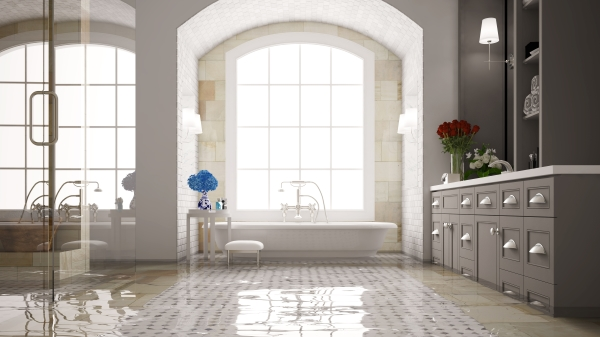
If you have tile floors in your home, you might assume that water can’t damage them. Unfortunately, water damage doesn’t stop with tile. It might be one of the best floorings at minimizing damage, but tile is not completely waterproof. Modern tile applications take additional steps in the manufacturing process to reduce the chance of water damage, but nothing is 100% waterproof.
How Does Water Damage a Tile Floor?
While some types of tile, like porcelain, are commonly referred to as “waterproof,” they aren’t. The tile is water-resistant, but not waterproof. Tiles—ceramic, travertine, stone, or porcelain are all porous to different degrees. Grout and thin-set (the adhesive used to keep the tile in place) are porous too.
Compared to carpeting or wood flooring, tile is significantly more water-resistant, which is why it’s a great choice for hallways, utility rooms, laundry rooms, bathrooms, kitchens, and commercial properties. It can also stand up to normal wear and tear, typical spills, and more.
However, when repeatedly soaked (from a leak) or submerged (in a flood), the tile will succumb to damage, along with the grout, thin set, and the subfloor below the tile. A soaked subfloor can eventually succumb to mold damage (which can create a potential health hazard).
Related Topic: 12 Ways to Revive Your Tile, Wood Floors, and Carpet
The 5 Signs of Water Damage Under Tile Floors
Water damage is often hard to identify because it’s hidden from plain sight. But there are five signs you should look out for:
- Staining: Water-damaged tiles are often stained. If you notice staining around the edges of your tiles and there is no obvious explanation for them, water may have reached through the sealant and darkened the tiles and surrounding grout.
- Loosening: Another telltale sign is loose tiles. Water can wear at the adhesive and once it gives out, the tile will start to come free from the floor. At this point, the surrounding tiles are likely affected as well, even if they aren’t loose yet.
- A hollow sound: To test if the moisture has reached behind or underneath the tiles, you can tap a coin and listen for a hollow sound. This indicates that the adhesive is giving out behind the tile and the tile may soon become loose.
- Warping: Water or moisture under the tile can damage the subfloor, in some cases warping the wood, or in other cases causing the floor to dip from the absence of adhesive or a rotting subfloor.
- Staining on the ceiling above or the floor below the tile: Water damage (staining) may be visible in the basement or on the ceiling below the tile in question.
Addressing Water Damage Behind Floor Tiles and Shower Tiles
Unfortunately, for both floor and wall tile (like in showers), by the time the damage has been discovered, it’s often too late—a professional can help determine if your tile has been irreparably damaged. Water damage is pervasive and progressive. Once it’s gone through or around the tile and reached a porous material like a subfloor or drywall, those materials will need to be replaced, and the space remediated and reconstructed.
Related Topic: How to Remove Hard Water Stains on Bathroom Tiles
What Can I Do to Prevent Water Damage in My New Build or Remodel?
Cleaning up after water damage can be messy and expensive. Here are some steps you can take to prevent damage at your property:
- Re-applying silicone sealant. A high-quality silicone sealant can help to prevent water from seeping behind tiles.
- Selecting the right materials for each job. Some tile materials are more water-resistant than others. Work with your designer or contractor to choose a tile that’s appropriate for your type of application and location.
- Opt for epoxy grout. Epoxy grout is a blend of two different resins with a filler that gives it durability against water damage and staining.
- Consider extra waterproofing measures.
Often used for baths and showers, the following building materials can be applied to provide an extra layer of moisture protection between the tile and the substrate.
Liquid membrane: This is a liquid-application waterproofing method, and whether applied to the floor or the walls or any other surface you want to protect from water damage (perhaps a shower bench), the liquid membrane is easily applied by brushing, rolling, or spraying.
Sheet membrane: Adding a sheet membrane requires a layer of primer, cutting in the corners, and fitting the sheet material to the floor or wall. Although there is more prep work to sheet membrane than to liquid membrane, you can be sure that no patches were left uncovered or missing a layer, since the sheet is cut to the exact size of the space.
Foam tile backer board: Although bulkier than either of the membrane methods, the foam backer boards are waterproofed on both sides, preventing water from absorbing into the wall or floor. Much like the sheet method, this waterproofing application is fitted to the space.
Rely on Rainbow Restoration for Damage Repair and Remediation
Although tile is a durable and versatile flooring material, it is not impervious to water damage. No matter the cause of your water damage, trust the IICRC-certified technicians at Rainbow Restoration to make it right. From remediation to full-service reconstruction, we have the know-how to restore your property fast. We hope you never need us, but we’re standing by in case you do. You can call us or request an online estimate for service.
